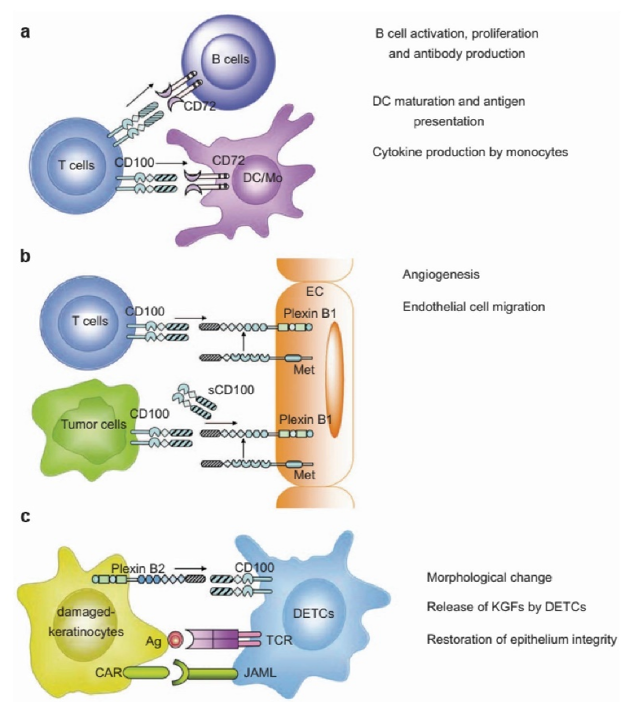
Our promise to you:
Guaranteed product quality, expert customer support.
 24x7 CUSTOMER SERVICE
24x7 CUSTOMER SERVICE
 CONTACT US TO ORDER
CONTACT US TO ORDER
SEMA4D Gene Editing 
Class IV semaphorin (Sema4D), also known as CD100, widely exists in the immune system and plays an important role in its functioning. It exists in the form of membrane-bound and soluble. In lymphoid tissue, the SEMA4D protein is so far known to be expressed by B cells, T cells, platelets, natural killer (NK) cells, and monocytes. The protein has a molecular weight of 150 kDa and consists of 862 amino acids. Sequence and structural analysis of the mature protein defines an extracellular, a transmembrane, and a cytoplasmic region. The extracellular region is composed of an immunoglobulin-like domain, a plexin–semaphorin–integrin domain, and an about 500 amino acids long semaphorin domain, which is conserved among all semaphorins. Soluble Sema4D (sSema4D) is formed by proteolytic cleavage, retaining the function of membrane analog.
SEMA4D Receptors and Signaling
The Sema 4D/CD100 molecule can bind to multiple receptors. CD72, a member of the C-type lectin family, is a low-affinity Sema 4D/CD100 receptor that is expressed on immune cells, such as dendritic cells, B cells, macrophages and mast cells. At least three Sema 4D/CD100 receptors are plexin family members. In B cells, tyrosine phosphorylation of CD72 results in recruitment of the tyrosine phosphatase SHP-1 to the immunoreceptor tyrosine-based inhibitory motif (ITIM) on the cytoplasmic tail of CD72. However, ligation with SEMA4D induces dephosphorylation of CD72 and disassociation of SHP-1. Plexin-B1, although mainly considered to be the SEMA4D receptor in non-lymphoid tissue, has also been found on T cells, platelets, follicular dendritic cells, and bone marrow stromal cells. Upon SEMA4D binding to plexin-B1 on epithelial cells, plexin-B1 forms a complex with the tyrosine kinase receptor Met, whose activity is enhanced and leads to phosphorylation of both receptors. Ligation of plexin-B1 has also been described to recruit small GTPases to the intracellular portion of plexin-B1, thereby regulating cytoskeleton dynamics. Recent reports have shown that SEMA4D can be used not only as a ligand, but also as a receptor for plexin-B2.
 Figure 1. Multiple functions mediated by Sema 4D/CD100-plexin B counter-receptors. (Zhang Y, et al., 2013)
Figure 1. Multiple functions mediated by Sema 4D/CD100-plexin B counter-receptors. (Zhang Y, et al., 2013)
SEMA4D and Cancer
Sema4D has been initially characterized in the nervous system, and its role in malignant cancer progression has been strongly implied during recent years. Sema4D has been reported to be highly expressed in several types of human cancers, such as prostate, breast, lung, colon, head and neck carcinomas. By cooperating with its high-affinity receptor plexinB1, Sema4D plays important roles in tumor cell proliferation, migration, survival, invasion, tumor angiogenesis and immunity. Dorfman et al. first reported that SEMA4D was expressed in most T cells of non-Hodgkin's lymphoma patients, suggesting that SEMA4D may have a regulatory role in malignant tumor development. So far, it has been widely studied that SEMA4D exerted a significant role in the regulatory of immune cells in the tumor microenvironment. Sierra et al. reported that macrophage-derived instead of platelets-derived SEMA4D is responsible for the vascular formation and progression of malignant tumor. In addition, neutralization of SEMA4D by anti-SEMA4D antibody could promote activated monocyte and anti-tumor T-cell tumor penetration illustrating that anti-SEMA4D therapy can be a novel method for the immunomodulatory therapy for tumor treatment.
SEMA4D Gene Editing Services
CRISPR/Cas9 PlatformCB, one of the leading biotechnological companies specializing in gene editing, is dedicated to offering comprehensive CRISPR/Cas9 gene-editing services to a wide range of genomics researchers. Based on our platform, we can help you effectively SEMA4D gene deleted, inserted or point mutated in cells or animals by CRISPR/Cas9 technology.
- SEMA4D Gene Knockout: We offer SEMA4D gene knockout cell line and knockout animal model generation service with high quality. Typically, we develop CRISPR-mediated gene editing cell lines including HEK239T, Hela, HepG2, U87, but we can use other cell lines according to your requirements. Our one-stop KO animal model generation service covers from sgRNA design and construction, pronuclear microinjection to Founders genotyping and breeding.
- SEMA4D Gene Knockin: CRISPR/Cas9 PlatformCB provides the one-stop SEMA4D knock-in cell line and knockout animal model generation services, including point mutation and gene insertion. Our expert staff has succeeded in dozens of SEMA4D knock-in cell line generation projects, including stem cells, tumor cells and even difficult-to-handle cells. We also have extensive experience in incorporating CRISPR/Cas9 technology into animal models, which have been fully recognized by our clients.
If you have any questions, please feel free to contact us.
Related Products at CRISPR/Cas9 PlatformCB
References
- Kuklina Е М, et al. Involvement of semaphorin (Sema4D) in T-dependent activation of B cells. Bulletin of Experimental Biology and Medicine, 2017, 163(4): 447-450.
- Maleki K T, et al. Soluble SEMA4D/CD100: a novel immunoregulator in infectious and inflammatory diseases. Clinical Immunology, 2016, 163: 52-59.
- Wang L, et al. The emerging roles of semaphorin4D/CD100 in immunological diseases. Biochemical Society Transactions, 2020, 48(6): 2875-2890.
- Xia Y, et al. The role of sema4D in vasculogenic mimicry formation in non‐small cell lung cancer and the underlying mechanisms. International journal of cancer, 2019, 144(9): 2227-2238.
- Zhang Y, et al. Sema 4D/CD100-plexin B is a multifunctional counter-receptor. Cellular & molecular immunology, 2013, 10(2): 97-98.